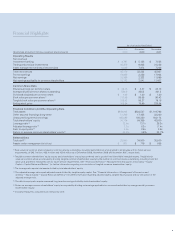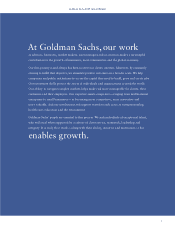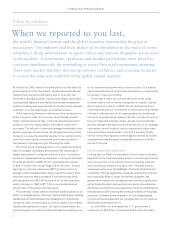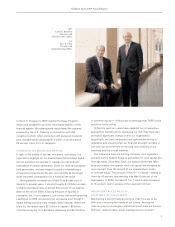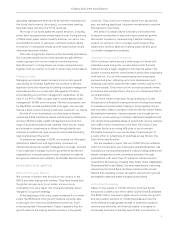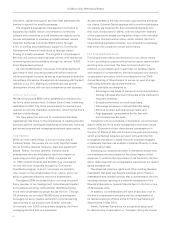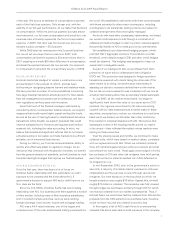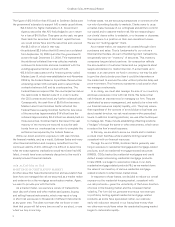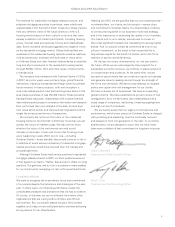Goldman Sachs 2009 Annual Report Download - page 9
Download and view the complete annual report
Please find page 9 of the 2009 Goldman Sachs annual report below. You can navigate through the pages in the report by either clicking on the pages listed below, or by using the keyword search tool below to find specific information within the annual report.
7
of the year. We accrue an estimate of compensation expenses
each of the rst three quarters. Only at year end, with the
visibility of our full-year performance, do we make nal decisions
on compensation. While the previous quarters’ accruals attract
much attention, our full-year compensation and bene ts to net
revenues ratio ultimately represents the rm’s compensation
expense. In 2009, that ratio was the lowest ever since we
became a public company — 35.8percent.
While 2009 total net revenues are only 2percent less than
the record net revenues that we posted in 2007, total
compensation and bene t expense is 20percent lower than in
2007, equating to a nearly $4billion difference in compensation
and bene ts expense between the two periods. Our approach
to compensation re ected the extraordinary events of 2009.
REGULATORY REFORM
GoldmanSachs has pledged to remain a constructive voice
and participant in the process of reform, and has been
forthcoming in recognizing lessons learned and mistakes made.
We have provided a number of recommendations concerning
how large nancial institutions should account for their assets,
how risk management processes can be enhanced, and how
new regulations can keep pace with innovation.
Given that much of the nancial contagion was fueled by
uncertainty about counterparties’ balance sheets, we support
measures that would require higher capital and liquidity levels,
as well as the use of clearinghouses for standardized derivative
transactions. More broadly, we support proposals that would
improve transparency for investors and regulators and reduce
systemic risk, including fair value accounting. In short, we
believe that sensible and signi cant reforms that do not impair
entrepreneurship or innovation, but make markets more ef cient
and safer, are in everyone’s best interest.
During our history, our rm has demonstrated an ability to
quickly and effectively adapt to regulatory change. As an
institution that interacts with thousands of entities, we bene t
from the general elevation of standards, and will continue to work
towards meaningful changes that improve our nancial system.
OUR RELATIONSHIP WITH AIG
Over the last year, there has been a lot of focus on
GoldmanSachs’ relationship with AIG, particularly our credit
exposure to the company and the direct effect the U.S.
government’s decision to support AIG had or didn’t have on our
rm. Here are the facts:
Since the mid-1990s, GoldmanSachs has had a trading
relationship with AIG. Our business with them spanned a number
of their entities, including many of their insurance subsidiaries.
And it included multiple activities, such as stock lending,
foreign exchange, xed income, futures and mortgage trading.
AIG was a AAA-rated company, one of the largest and
considered one of the most sophisticated trading counterparts in
the world. We established credit terms with them commensurate
with those extended to other major counterparts, including
a willingness to do substantial trading volumes but subject to
collateral arrangements that were tightly managed.
As we do with most other counterparty relationships, we limited
our overall credit exposure to AIG through a combination of
collateral and market hedges in order to protect ourselves against
the potential inability of AIG to make good on its commitments.
We established a pre-determined hedging program, which
provided that if aggregate exposure moved above a certain
threshold, credit default swaps (CDS) and other credit hedges
would be obtained. This hedging was designed to keep our
overall risk to manageable levels.
As part of our trading with AIG, we purchased from them
protection on super-senior collateralized debt obligation
(CDO) risk. This protection was designed to hedge equivalent
transactions executed with clients taking the other side of the
same trades. In so doing, we served as an intermediary in
assisting our clients to express a de ned view on the market.
The net risk we were exposed to was consistent with our role as
a market intermediary rather than a proprietary market participant.
In July 2007, as the market deteriorated, we began to
signi cantly mark down the value of our super-senior CDO
positions. Our rigorous commitment to fair value accounting,
coupled with our daily transactions as a market maker in these
securities, prompted us to reduce our valuations on a real-time
basis which we believe we did earlier than other institutions.
This resulted in collateral disputes with AIG. We believe that
subsequent events in the housing market proved our marks
to be correct — they re ected the realistic values markets were
placing on these securities.
Over the ensuing weeks and months, we continued to make
collateral calls, which were based on market values, consistent
with our agreements with AIG. While we collected collateral,
there still remained gaps between what we received and what
we believed we were owed. These gaps were hedged in full by
the purchase of CDS and other risk mitigants from third parties,
such that we had no material residual risk if AIG defaulted on
its obligations to us.
In mid-September 2008, prior to the government’s action to
save AIG, a majority of GoldmanSachs’ exposure to AIG was
collateralized and the rest was covered through various risk
mitigants. Our total exposure on the securities on which we
bought protection was roughly $10billion. Against this, we held
roughly $7.5billion in collateral. The remainder was fully covered
through hedges we purchased, primarily through CDS for which
we received collateral from our market counterparties. Thus, if
AIG had failed, we would have had the collateral from AIG and the
proceeds from the CDS protection we purchased and, therefore,
would not have incurred any material economic loss.
In this regard, a list of AIG’s cash ows to counterparties
indicates little about each bank’s credit exposure to the company.
Goldman Sachs 2009 Annual Report


